You will be captivated by the lava-like filling flowing out when you tear open this Chinese custard bao (Liu Sha Bao).
The filling is a little sweet, creamy, and most noticeably the slightly salty, sandy and lava-like texture of the mashed salted eggs yolk. The molten, lava-like filling is the characteristic of this unique Cantonese dim sum.
This custard bao is called 黃金流沙包 in Chinese. It is also translated as Liu Sha Bao / Liu Sa bao/ salted egg custard steamed buns / molten lava bun/cream custard bao.
This recipe is loosely based on the work by chef Zhu Limi, with my interpretation. The filling is like thick lava. There are many Chinese Dum Sum restaurant served the custard bao with more runny filling. I have the recipe of the more flowy filling in the following section. However, this less flowy recipe is so much more flavorful.
Note: This post may contain affiliate links. Please read my privacy policy for more info. I may receive commissions for purchases made through links in this post.

1. Prepare the custard filling
The quantity of each ingredient is crucial to achieving this kind of texture.
Here are the steps:
- Separate the salted egg yolk from the white. Remove as much egg white attached to the egg yolk as possible. Steam the egg yolk for five minutes, or depends on the heat that you use. Make sure the yolks are fully cooked to attain the sandy texture.
- Mash the cooked salted egg yolk with the blade of the cleaver or a fork.
- Get a regular hard boil egg and mash the yolk only. Set aside.
- Measure the amount of butter required in a mixing bowl.
- Add the icing sugar to the melted butter and cream both ingredients to form a buttercream.
- Add the milk powder, and custard powder. Mix well.
- Finally, combine the above with the mashed egg yolk. Mix until there are no visible pieces of egg yolk. You may consider using the electric mixer if the quantity is large.
- At this moment, the mixture is too soft to use it as the filling. Therefore, place the mixture in the refrigerator until it becomes semi-solid, which may take half to one hour.
- Once it is firmed enough to handle, remove from the refrigerator, and divide the filling into an equal portion of 15g to 17g each.
- Use your palms to roll each portion to the shape of a ball. Keep it in the refrigerator if you are not using it right away. Let it chills further to a state that you can handle it with ease before using it as the filling.
Note: Salted egg is very popular among the Chinese. Check out how to use salted egg yolk to prepare the traditional mooncake with lotus paste.
The alternate filling that is runnier
I like the thicker, mud-like texture, which I can describe the filling as ‘molten golden sand’. 🙂
However, if you prefer a runnier version that is popular in some Chinese dim sum store, please follow the formula below to replace the filling mentioned in the recipe. It is your preference, but I am a little paranoid of this version as my tongue got burned by the sudden flow of hot filling oozing out from the hot bao.
25g unsalted butter
50g sugar
10g milk
12g custard powder
8g milk powder
30g salted egg yolk
Note that this recipe contains milk to make the filling runnier.
2. Making the dough
Making the dough is straightforward. The method is similar to making bread, except it also contains baking powder, in addition to yeast.
I prefer to mix the ingredients in a bowl first instead of pouring the floor onto the working table directly. It is neater to work this way.
Here are the steps:
- Sprinkle the active dry yeast to the water in the mixing bowl. Stir to dissolve the yeast.
- Add the icing sugar and mix until it dissolves.
- Add the flour and baking powder.
- Mix until it forms a dough.
- Now use your clean hand to knead the dough, until the dough picks up all the remaining flour in the bowl.
- Place the dough on a floured surface. Knead the dough until it becomes elastic, and shining. This method is identical to kneading bread dough.
- Divide the dough into portions, 35g each.
- Cover the dough with a piece of damp cloth (or cling wrap) and set aside.
The dough is now ready for the next step.
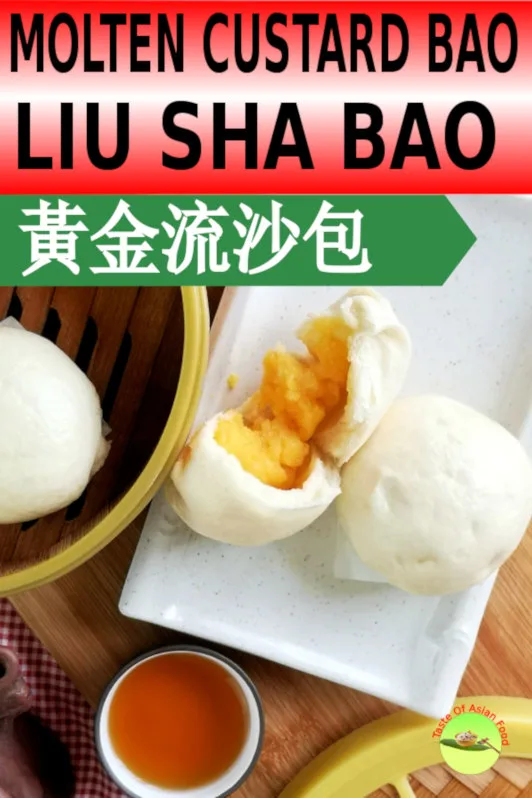
3. Wrapping the filing
This section is perhaps the most challenging part of this Liu Sha Bao recipe. There are two challenges here:
- The filling is sticky and difficult to handle.
- The filling will leak if the bao is not sealed correctly.
I have mentioned in detail how to handle the filling in the ‘Prepare the custard filling’ section. Let’s see how to ensure the filling do not leak out from the dough.
- Roll out a portion of the dough to a rectangle. Then fold into half. Turn ninety degrees and roll it out again to a rectangle. Repeat this folding process three times. Fold the dough will make it more shining and stretchy, which looks better after steaming.
- Let it relax for five minutes.
- Place a portion of the chilled filling at the center.
- Fold the dough towards the center top and seal the dough. Place it on one hand and keep rotating it. Use the thumb and the index finger of the other hand to form a ‘C’ shape arc to squeeze and close up the seam of the dough, at the same time rotate the bao with the other hand. This motion will work the custard into the dough, and the squeezing will seal up the seam. Remove any excess dough. (Please refer to the video for demo.)
- Turn the dough upended, and place it on a piece of oiled baking paper. Let it proof for ten to fifteen minutes. You do not need to wait until it doubles in size like making bread. There is baking powder in the recipe!
- Steam the bao over medium heat for eight minutes. Serve immediately.
More tips on how to make Liu Sha Bao
Here are eight important tips to ensure that you can make the best Liu Sha Bao.
- The dough for the Liu Sha Bao should have the right amount of water:
- If it is too dry, the seam will not properly close when you press and squeeze. The filling oozes out during steaming.
- The bao will be out of shape if it is too wet (flat instead of standing tall). Try to adjust the amount of water to just enough to form the dough.
- If you do not have custard powder, substitute it with cornstarch. Custard powder is a mixture of cornstarch (the principal component) with some coloring and flavoring agents.
- Use pao (bao) flour, which is the specialty flour for bao. I get it from the bakery specialty shop in Asia. Use the regular cake flour or all-purpose flour as the substitute if it is not available. The most significant advantage of using pao flour is to be able to produce bao with near-white color.
- Use a little more dough than necessary to make sure the bao is completely sealed. I will use a few grams of extra dough and remove the excess dough at the end. The general rule is one part of the filling with two parts of dough for each bao. You can use the leftover dough to make another liu sha bao.
- Do not stretch the dough when sealing up the dough. If you pull it, the dough will become thin at a particular area that may burst during steaming. Seal by squeezing the thick dough near to the closure gently instead.
- Steam over moderate heat. The filling inside the dough will burst out quickly when it is steamed over high heat. Use medium heat to steam is the best.
- Rest the bao for fifteen minutes before steaming. Do not wait for too long as the yeast will further expand the volume and it will leave a gap between the dough and the filling. Eventually, the dough will rise too much and become out of shape after steaming.
- Too much steam can cause surface wrinkly. Try to use medium heat or lift one side of the cover by putting a chopstick in between the lid and the pot/wok to allow the steam to escape.
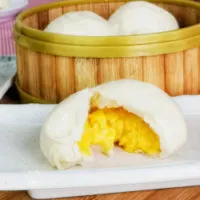
Liu Sha Bao recipe
This Custard bao is called Liu Sha Bao 流沙包. The filling is a little sweet, creamy, and most noticeably the slightly salty, sandy and muddy texture of the mashed salted eggs yolk. The molten, lava-like filling is the character of this unique Cantonese dim sum.
Ingredients
For the filling:
- 3 salted egg yolk
- 1 regular chicken egg yolk
- 35g unsalted butter
- 40g icing sugar
- 3g custard powder
- 20g milk powder
For the dough;
- 120ml water
- 2g active dry yeast
- 10g sugar
- 2g baking powder
- 225g bao flour
Instructions
Prepare the custard filling
Steam salted the egg yolk for five minutes.
Mash it with the blade of the cleaver or a fork.
Get a regular hard boil egg and mash the yolk only. Set aside.
Combine the butter with the icing sugar.
Add the milk powder, custard powder. Mix well.
Combine the above with the mashed egg yolk.
Chill for half to one hour.
Divide the filling into an equal portion of 15g to 17g each.
Making the dough
Sprinkle the active dry yeast to the water.
Add the icing sugar and mix until it dissolves.
Add the flour, baking powder. Mix until it forms a dough.
Knead the dough until it becomes elastic, and shining.
Divide the dough into 35 g portions.
Wrap the filling
Roll out a portion of the dough to a rectangle. Then fold into half. Turn ninety degrees and roll it out again to a rectangle. Repeat this process three times. Let it relax for five minutes.
Place a portion of the chilled filling at the center. Wrap with the dough. Make sure it is completely sealed.
Turn the dough upended, and place it on a piece of oiled paper. Let is rest for ten to fifteen minutes.
Steam the bao over medium heat for eight minutes. Serve immediately.
Recommended Products
As an Amazon Associate and member of other affiliate programs, I earn from qualifying purchases.
Nutrition Information:
Yield: 8 Serving Size: 8 baosAmount Per Serving: Calories: 204Total Fat: 7gSaturated Fat: 3gTrans Fat: 0gUnsaturated Fat: 3gCholesterol: 83mgSodium: 137mgCarbohydrates: 29gFiber: 1gSugar: 7gProtein: 6g
This data was provided and calculated by Nutritionix on 8/3/2019

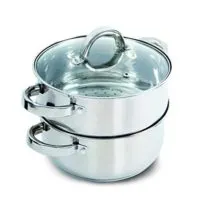
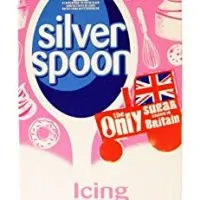
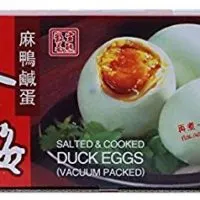
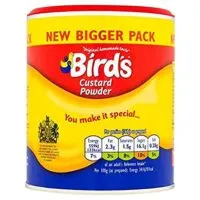
Emily
Monday 15th of March 2021
Hi thanks for your wonderful recipe. I did the normal version first then the runnier version. I was too fast in pouring the milk and ended up with 20g instead of 10g. However right after steaming and opening the filling did not flow at all and remain as though it was the more solid version. I stuck to everything else as per your recipe. Why did my filling not flow? Do I have to steam for a longer time?
KP Kwan
Wednesday 17th of March 2021
I don't think steaming longer will work. Custard powder is essentially starch that will prevent anything from flowing if it is too much. I am suspecting that is the cause. Try to reduce the custard powder by half to make it flow.
Thao Nguyen
Saturday 19th of September 2020
Hi KP Kwan, thanks for the great recipe. If i wanted it prepared it and freeze it so i can eat it when i am craving for. I can i do it so that the filling can still be running each time i cooked it? Does the bao need to be cooked before put them in to the freezer?
KP Kwan
Saturday 19th of September 2020
Hi Thao Nugyen, I suggest you steam the bao and let it cool, then freeze it. When you want to eat, let it defrost and steam again. That is how some of the Dim Sum restaurants are doing. KP Kwan
Sally
Friday 31st of July 2020
Hi, in the recipe it says that you used bao flour. What kind of flour is that? Can I use all purpose flour or bread flour instead? Thanks!
KP Kwan
Saturday 1st of August 2020
Hi Sally, There is bao flour available at where I live. It is a unique mix that I suitable for making bao. Use can use all-purpose flour or the regular flour (those for making cakes) for this recipe. KP Kwan
Holly
Wednesday 15th of July 2020
Hi I made your recipe for both the salty egg custard fillings Both are very delicious. How many yields does the runny version make as the quantity is very little for the filling and I had to make extra which resulted in excess. What size do you make for the runny version
KP Kwan
Wednesday 15th of July 2020
Hi Holly, My recipe is only for eight baos. The size of the dough is 35g, and the filling is 15g. You need to increase the amount of all the ingredients proportionately for a larger batch. KP Kwan
Mandy
Tuesday 7th of July 2020
Hi, can I make this with all-purpose flour instead of bread flour? I have not had any luck finding bread flour in any supermarkets.
Also, your instructions of making the dough seemed a little different from the video. In the video, it looks like the chef poured the flour on the counter then the yeast and baking powder and sugar before he poured water on top of the mix. Does both method work?
Thanks!
KP Kwan
Wednesday 8th of July 2020
Hi Mandy, 1. You can use all-purpose flour if bread flour is not available. 2. The sequence of adding the ingredients has no significant impact on this recipe. Active dry yeast and baking powder should work well in both ways. Thanks, KP Kwan